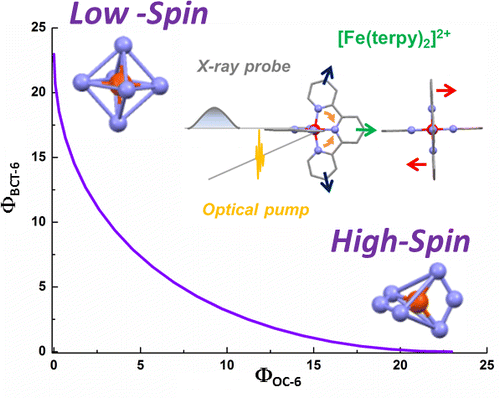
|
Photophysics and Photochemistry of Transition Metal Compounds |
| Home Research Members Collaborations Publications |

|
 |
|||||||
Establishing a tractable yet complete reaction coordinate for the spin-state interconversion in d4–d7 transition metal complexes is an integral aspect of controlling the dynamics that govern their functionality. For spin crossover phenomena, the limitations of a single-mode approximation that solely accounts for an isotropic increase in the metal–ligand bond length have long been recognized for all but the simple octahedral monodentate FeII compounds. However, identifying the coupled deformations that also impact on the unimolecular rate constants remains experimentally and theoretically challenging, especially for samples that do not display long-range order or when crystallization profoundly alters the dynamics. Owing to the rapid progress in ultrafast X-ray absorption spectroscopy (XAS), it is now possible to obtain transient structural information in any physical phase with unprecedented details. Using picosecond XAS and DFT modeling, the structure adopted by the photoinduced high-spin state of solvated [Fe(terpy)2]2+ (terpy: 2,2′:6′,2″-terpyridine) has been recently established. Based on these results, the methodology of the continuous shape measure is applied to classify and quantify the short-lived distortion of the first coordination shell. The reaction coordinate of the spin-state interconversion is clearly identified as a double axial bending. This finding sets a benchmark for gauging the influence of first-sphere and second-sphere interactions in the family of FeII complexes that incorporate terpy derivatives. Some implications for the optimization of related photoactive FeII complexes are also outlined. | ||||||||
|
||||||||
Characterizing structural distortions in the metastable spin states of d4–d7 transition metal ion complexes is crucial to understand the nature of their bistability and eventually control their switching dynamics. In particular, the impact of the Jahn–Teller effect needs to be assessed for any electronic configuration that could be effectively degenerate, as in e.g. the high-spin (HS) manifold of highly symmetric homoleptic FeII complexes. However, capturing its manifestations remains challenging since crystallization generally alters the molecular conformations and their interconversion. With the rapid progress of ultrafast X-ray absorption spectroscopy, it is now possible to collect data with unprecedented signal-to-noise ratio, opening up for detailed structural characterization of transient species in the homogeneous solution phase. By combining the analysis of picosecond X-ray absorption spectra with DFT simulations, the structure of the photoinduced HS state is elucidated for solvated [Fe(terpy)2]2+ (terpy = 2,2′:6′,2″-terpyridine). This species can be viewed as the average 5B structure in D2 symmetry that originates from a dynamic Jahn–Teller effect in the HS manifold. These results evidence the active role played by this particular instance of vibronic coupling in the formation of the HS state for this benchmark molecule. Ultimately, correlating the interplay between intramolecular and intermolecular degrees of freedom to conformational strain and distortions in real time should contribute to the development of advanced functionalities in transition metal ion complexes. | ||||||||
 |
|
|||||||
For numerous spin crossover complexes, the anisotropic distortion of the first coordination shell around the transition metal center governs the dynamics of the high-spin/lowspin interconversion. However, this structural parameter remains elusive for samples that cannot be investigated with crystallography. The present work demonstrates how picosecond X-ray absorption spectroscopy is able to capture this specifi c deformation in the photoinduced high-spin state of solvated [Fe(terpy)2 ]2+ , a complex which belongs to the prominent family of spin crossover building blocks with nonequivalent metal− ligand bonds. The correlated changes in Fe−NAxial , Fe− NDistal , and bite angle NDistal− Fe− NAxial extracted from the measurements are in very good agreement with those predicted by DFT calculations in D2d symmetry. The outlined methodology is generally applicable to the characterization of ultrafast nuclear rearrangements around metal centers in photoactive molecular complexes and nanomaterials, including those that do not display long-range order. | ||||||||
Download this list in format RIS
 EndNote
EndNote  BibTex
BibTex  PDF XML
PDF XML Last update Friday December 08 2017